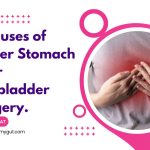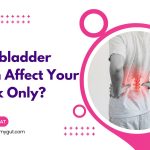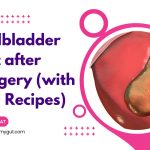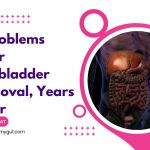6 Causes of Bigger Stomach after Gallbladder Surgery.
Our content is not intended nor recommended as a substitute for medical advice by your doctor. Use for informational purposes only.
Key insights:
Gas is the most common reason your stomach feels big after a gallbladder operation.
After gallbladder surgery (and many other abdominal operations), your stomach, small intestine, and colon move slower than normal for a few days.
The slowing down of the bowels and the stomach is the most common cause of a bigger stomach after cholecystectomy because of the accumulated gas.
In most cases, the condition is temporary and resolves within a few days.
Today, you will learn the possible causes of a bigger stomach after gallbladder surgery.
The focus will be on the short-term causes of distension in the days after the cholecystectomy. However, we will also discuss other possible causes of long-term abdominal distension in this type of surgery.
1. Anaesthesia & analgesia side effects (commonest cause).
For the first few hours to days after the gallbladder operation, the anesthetic medications received during the operation continue to have some effects.
The major side effect of anesthetic medications is gastrointestinal. Anesthetic medications produce temporary paralysis of the small muscles in the wall of the bowel and stomach.
Your stomach and bowels remain (lazy) for a few days after the operation.
Also, patients with cholecystitis often receive strong analgesics. Commonly, doctors use opioid analgesics for pain relief before and after the gallbladder removal operation.
Opioid analgesics slow down the motility of your intestine, leading to side effects such as severe constipation and gaseous distension.
Common examples of opioid analgesics include:
- Morphine.
- Meperidine.
- Hydromorphine
- Fentanyl.
Opioids are also part of anesthesia medications that are given during the operation.
Up to 90% of patients receiving opioid analgesics suffer from constipation and slow motility of the bowel.
Symptoms and diagnosis:
- Diffuse abdominal distension (stomach looks bigger than normal).
- The onset is often immediately after the gallbladder removal surgery. The distension peaks in the first few days and disappears gradually with proper treatment and mobility.
- Nausea.
- Constipation.
- Colics.
- Flatulence (passing too much gas).
- Positive history of too many analgesics (particularly opioid analgesics).
Tips for relieving distension caused by anesthesia and analgesics:
- If you still receive opioid analgesics in the postoperative period, discuss with your doctor the possibility of decreasing the dose, stopping it completely, or shifting to another analgesic.
- Start to move as early as possible; prolonged incumbency worsens your stomach’s distension.
- Stay hydrated. Dehydration due to anorexia and abdominal pain may contribute to sluggish bowel motility.
- Eat small meals with bland foods.
- Avoid gas-producing food, fatty foods, and large meals.
- In cases of severe constipation and abdominal distension, a stimulant laxative (as bisacodyl) or suppository may help (ask your doctor about the best option).
- A stool softener may also help.
2. Prolonged bed recumbency after cholecystectomy.
Your doctor often instructs you to move as early as possible after cholecystectomy. That’s because your physical activity (even if slight) helps your stomach and bowel regain motility.
On the other hand, prolonged unnecessary recumbency after gallbladder removal will cause delayed recovery of your bowel motility.
Food will stay longer in your intestine, and gas will build up if you continue to have lazy bowels after the operation. As a result, distension of the abdomen occurs, and your stomach will look bigger after the operation.
Common causes of prolonged recumbency include:
- Elderly patients.
- Severe postoperative pain or poor tolerance to pain.
- Presence of complications.
- Presence of chronic debilitating diseases.
- Patients who are unaware of the importance of moving after the operation.
When should you start moving after a cholecystectomy operation?
In patients without contraindication or complications, your surgeon will often advise you to start moving the next day of the operation.
On the first day, you may feel tired and dizzy, so moving is not often advised on the first day.
What type of activity? and for how long?
After the first day of rest, you should start moving as soon as possible. Start with short walks inside your room for no more than 5 minutes.
If the first walk goes OK, then you can repeat it after a while, for a longer period. Then, you can gradually increase the activity over the next few days.
Avoid prolonged hours of bed recumbency for grueling hours with any move. Also, avoid strenuous activity or heavy lifting for at least two weeks after the operation.
When you start moving, your stomach and bowels often regain their motility, and the distension (big stomach feeling) will disappear.
3. Prolonged manipulation of the intestine during the cholecystectomy operation.
Your intestine can be manipulated too much during gallbladder removal, especially in complicated cases.
If your operation was difficult, prolonged, or if you have complicated acute cholecystitis (as gangrene or perforation), then excessive intestinal manipulation during the surgery is expected.
Excessive bowel manipulation during the surgery strongly correlates with delayed recovery of intestinal movement (reference).
Moreover, severe cases may end in complete paralysis of the bowel muscles (postoperative paralytic ileus). See Later.
Often, your doctor will discuss the details of the operation and the possible outcomes if the operation is complicated.
There is nothing to do except for the standard advice such as early movement, stimulant laxatives, small frequent meals, bland food, etc.
Report any abnormally severe symptoms such as persistent vomiting, tender stomach, fever, or prolonged constipation for several days after surgery.
4. Severe postoperative pain.
Pain after gallbladder removal surgery (or any surgery) is the commonest symptom. However, tolerable levels of pain often don’t cause any issues.
However, if the pain is extreme, it may cause delayed recovery of your intestinal and gastric motility.
The common causes of severe post-cholecystectomy pain in the few days after the operation include:
- Patients who undergo open rather than laparoscopic cholecystectomy often feel more pain.
- Patients with complicated cholecystitis (abscess, gangrene, perforation) often have prolonged and more severe postoperative pain.
- Patients who have a low threshold to pain (particularly females).
- Peritoneal inflation with gas during laparoscopic cholecystectomy.
Severe pain leads to reflex inhibition of the intestine motility and delayed recovery. And your stomach will look bigger due to gas distension.
A painkiller will greatly improve pain. However, the most frequently used pain killers, opioid analgesics, may aggravate the condition as they inhibit intestinal motility.
Other pain killers such as NSAIDs (ibuprofen, ketoprofen, etc.) don’t affect intestinal motility as an opioid.
Although less effective than opioid analgesics, NSAIDs can provide good pain relief without significant effects on intestinal motility. Discuss the issue with your doctor.
5. Postoperative paralytic ileus.
Paralytic ileus is a complete (often temporary) loss of small intestinal motility. As a result, food stops moving through the intestine completely.
Paralytic ileus occurs to some degree after all abdominal operations, including gallbladder removal.
Patients with prolonged paralytic ileus develop symptoms identical to intestinal obstruction.
Causes:
Several factors cause paralytic ileus. And often, these causes occur together in the same patients after abdominal operations such as cholecystectomy.
Common causes include:
- Diffuse or localized abdominal inflammation (often due to complicated cholecystitis).
- Manipulation of the small intestine during surgery.
- Anesthetic medications.
- Opioid analgesics.
- Severe electrolyte disturbances (especially hypokalemia).
- And others.
Symptoms of post-cholecystectomy paralytic ileus:
- Symptoms often start in the first few days after the operation.
- No bowel movements (not defecation).
- Delayed passage of or inability to pass flatus.
- Severe abdominal distension (your stomach looks bigger after the operation.
- Persistent nausea sensation.
- Recurrent or persistent vomiting.
- Inability to tolerate oral diet.
When your doctor suspects post-cholecystectomy paralytic ileus, he will order some investigation such as an abdominal radiograph (X-ray, CT abdomen, or contrast study) and laboratory tests.
Treatment (reference):
- Correction of any underlying cause such as electrolyte disturbances (low blood potassium is the commonest cause).
- Intravenous fluids for hydration (as there is poor oral intake).
- Encouragement of mobility (walking).
- Treatment of any infection or sepsis.
- Discontinue any medication that aggravates the condition ( such as opioid analgesics).
- Paralytic ileus often resolves with time in most patients after correcting the cause.
6. Others.
Other possible causes of a bigger-looking stomach after gallbladder surgery:
- Severe electrolyte disturbances.
- Fat intolerance due to bile acid malabsorption after the gallbladder removal.
- Chronic medical conditions such as diabetes mellitus.
- Serious complications such as bile leakage or hematoma.
- Weight gain.
When to see a doctor for a bigger stomach after cholecystectomy?
See a doctor if the bigger-looking stomach is associated with:
- Severe intolerable abdominal pain.
- Prolonged constipation for more than three days after the gallbladder surgery.
- No passage of flatus after the operation.
- Persistent nausea or vomiting.
- Fever.
- Inability to tolerate oral foods or fluids.
- Shortness of breath.
- Dizziness, confusion, or coma.
- Fast heartbeats.
- Evidence-based
- Written by a doctor.






